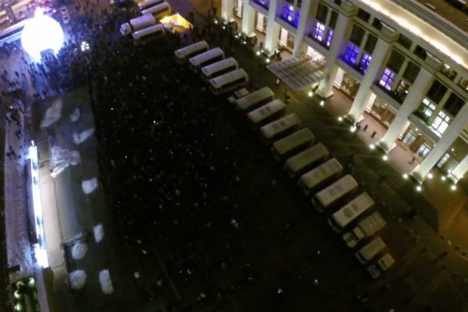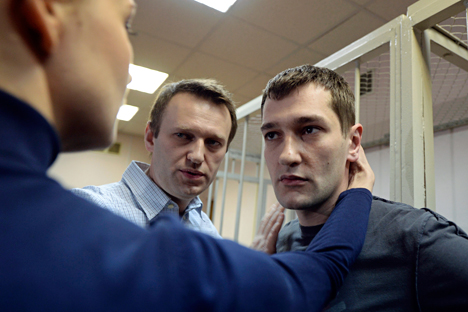Everything you wanted to know about the Dec. 30 rally in support of Navalny

Still from a video shot by a drone at Manezhnaya Square on Dec. 30. Source: Karlsson Project/Vimeo.com
Dec. 30 could be described as the day of the Russian opposition in 2014. In terms of the saturation of the coverage of events online and the intensity of emotions among opposition-minded Russians, the news takes second place this year only to the Winter Olympics in Sochi. It’s quite difficult to describe it all in one text, as each episode generated its own separate series of articles in the Russian media, but I have tried to combine everything to give a general overview of events as they unfolded.
1. The rally was organized all of a sudden
Originally it was planned to hold a rally in support of leading opposition politician Alexei Navalny on Jan. 15. However, the court suddenly decided to postpone the sentencing of the Navalny brothers from Jan. 15 to Dec. 30. The information about the Dec. 30 meeting on Manezhnaya Square appeared only on Dec. 29. In the next 24 hours a group on Facebook dedicated to the yesterday’s rally, gained more over 16,000 participants.
2. The sentence was unexpected for everyone
On the morning of Dec. 30 the Moscow court announced the final verdict in the so-called Yves Rocher fraud case. The court gave Alexei Navalny a suspended sentence of 3.5 years, but his brother Oleg – who has no public profile to speak of – got a full sentence of 3.5 years.
The court’s decision came as a surprise to many: No one was anticipating that the sentence could be softened or might even be suspended. The day before, all the country’s liberal media were talking about a jail term and comparing Navalny’s trial to the political arrest of oligarch and former Yukos head Mikhail Khodorkovsky, who was imprisoned for 10 years. Earlier it was reported that the court could convict the Navalny brothers to a period of 8 to 10 years.
3. Alexei Navalny was not admitted to the rally
In the evening of Dec. 30, Alexei Navalny violated his house arrest and went to Manezhnaya Square, writing on Facebook: "House arrest - sure, but today I'd like to be with you. So I’m coming too." OMON riot police detained the politician near the square, after which he was returned home.
Домашний арест-это да, но сегодня мне очень хочется быть с вами. Поэтому я тоже еду. #Манежкаpic.twitter.com/xkWGX0Hp4F
— Alexey Navalny (@navalny) 30 декабря 2014
4. The meeting was more modest than the previous one
The rally on Manezhnaya Square started at 7 p.m. on Dec. 30 and lasted until 9pm. The number of protesters was fewer than expected - according to various estimates, the demonstration gathered only about 1,500-3,000 people:
A video shot by a drone at Manezhnaya Square on Dec. 30. Source: Karlsson Project on Vimeo.
This is not the first mass demonstration organized in response to a legal case involving Alexei Navalny. The previous meeting on July 18, 2013, held on Manezhnaya Square to protest against the so-called Kirov forestry fraud case, drew about five times more participants:
A video shot from a helicopter at Manezhnaya Square on Jul. 18, 2013. Source: Комсомольская Правда on Youtube.com
In general, people at the Dec. 30 rally behaved less vigorously – there were no posters, labels, badges, stickers or protest chants. It seemed that people were just standing in groups on the square and quietly discussing something in private conversations. But the spirit was cheerful.
5. The protesters have mastered new technologies
Curiously, the protesters have started using FireChat, an instant messaging client that operates without access to the internet. The San Francisco-based company Open Garden, the developer of FireChat, reported a sharp increase in demand for the service in Russia on Dec. 29, reports Russian daily Vedomosti. The same application was used by protesters in recent demonstrations in Hong Kong and Taiwan.
For the entire year, the Russian opposition has acted very passively, as if it had fallen into a lethargic sleep in the circumstances of the phenomenal growth of the president’s rating, the Olympic victories and all the Crimea-Ukraine news. By November, it seemed obvious to everyone that the "second opinion" in Russia had been completely forgotten.
However, on Dec. 30 opposition held a rally by a single occasion. And this occasion, just like 1.5 years ago, was a trial of the principal figurehead of Russian opposition politics – Alexei Navalny.
For sure, yesterday's rally was less spectacular: no more pasting stickers with the name Navalny on the State Duma building , no more sarcastic protest posters, and the number of participants was not really impressive in itself. But the fact that the opposition could rise from the ashes in the space of just 24 hours is breathtaking.
It means that fascinating processes are still at work in Russian society – processes that arecapable of affecting the country’s authorities and the mood of the population as a whole. And this simple observation in itself is already a good opportunity for reflection.
All rights reserved by Rossiyskaya Gazeta.
Subscribe
to our newsletter!
Get the week's best stories straight to your inbox

